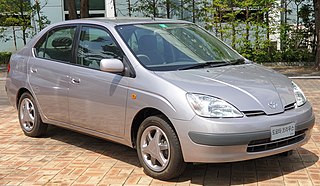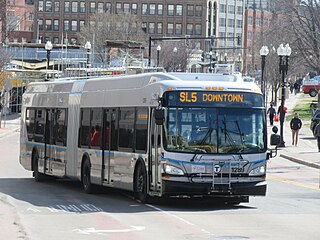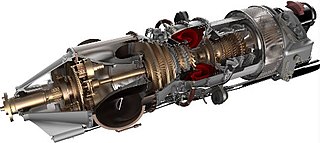Related Research Articles

A hybrid vehicle is one that uses two or more distinct types of power, such as submarines that use diesel when surfaced and batteries when submerged. Other means to store energy include pressurized fluid in hydraulic hybrids.

An aircraft engine, often referred to as an aero engine, is the power component of an aircraft propulsion system. Aircraft using power components are referred to as powered flight. Most aircraft engines are either piston engines or gas turbines, although a few have been rocket powered and in recent years many small UAVs have used electric motors.

An electric vehicle (EV) is a vehicle that uses one or more electric motors for propulsion. It can be powered by a collector system, with electricity from extravehicular sources, or it can be powered autonomously by a battery. EVs include but are not limited to road and rail vehicles, and broadly can also include electric boat and underwater vessels, electric aircraft and electric spacecraft.

The aircraft diesel engine or aero diesel is a diesel-powered aircraft engine. They were used in airships and tried in aircraft in the late 1920s and 1930s, but were never widely adopted until recently. Their main advantages are their excellent specific fuel consumption, the reduced flammability and somewhat higher density of their fuel, but these have been outweighed by a combination of inherent disadvantages compared to gasoline-fueled or turboprop engines. The ever-rising cost of avgas and doubts about its future availability have spurred a resurgence in aircraft diesel engine production in the early 2010s.

An electric aircraft is an aircraft powered by electricity. Electric aircraft are seen as a way to reduce the environmental effects of aviation, providing zero emissions and quieter flights. Electricity may be supplied by a variety of methods, the most common being batteries. Most have electric motors driving propellers or turbines.

A hydrogen-powered aircraft is an aeroplane that uses hydrogen fuel as a power source. Hydrogen can either be burned in a jet engine or another kind of internal combustion engine, or can be used to power a fuel cell to generate electricity to power an electric propulsor. It cannot be stored in a traditional wet wing, and hydrogen tanks have to be housed in the fuselage or be supported by the wing.
Hybrid vehicle drivetrains transmit power to the driving wheels for hybrid vehicles. A hybrid vehicle has multiple forms of motive power.

A hybrid electric vehicle (HEV) is a type of hybrid vehicle that combines a conventional internal combustion engine (ICE) system with an electric propulsion system. The presence of the electric powertrain is intended to achieve either better fuel economy than a conventional vehicle or better performance. There is a variety of HEV types and the degree to which each function as an electric vehicle (EV) also varies. The most common form of HEV is the hybrid electric car, although hybrid electric trucks, buses, boats and aircraft also exist.

The Clean Sky Joint Undertaking (CSJU) is a public-private partnership between the European Commission and the European aeronautics industry that coordinates and funds research activities to deliver significantly quieter and more environmentally friendly aircraft. The CSJU manages the Clean Sky Programme (CS) and the Clean Sky 2 Programme (CS2), making it Europe's foremost aeronautical research body.

The RED A03 is a V12 four-stroke aircraft diesel engine designed and built by RED Aircraft GmbH of Adenau, Germany.

The General Electric Catalyst is a turboprop engine by GE Aviation. It was announced on 16 November 2015 and will power the Beechcraft Denali, it first ran on December 22, 2017, and should be certified in 2024. The 850 to 1,600 hp engine aims for 20% better efficiency than its competition thanks to a 16:1 overall pressure ratio, variable stator vanes, cooled turbine blades, 3D printed parts and FADEC.

The Yakovlev Yak-152 is a Russian primary trainer aircraft from the Yakovlev Design Bureau, part of the Irkut Corporation. The prototype Yak-152 first flew on 29 September 2016, powered by a RED A03 diesel engine, rated at 500 shp (370 kW). The aircraft has been ordered by the Russian Aerospace Forces to replace its current Yakovlev Yak-52 trainers.

The Siemens-FlyEco Magnus eFusion is a German hybrid diesel-electric aircraft that was designed by Siemens and FlyEco, introduced at the AERO Friedrichshafen show in 2018. The aircraft is intended for series production as a ready-to-fly design.
magniX is an electric motor manufacturer for electric aircraft, wholly owned by Singapore investor Clermont Group. The company is headquartered in Everett, Washington, United States.

The VoltAero Cassio is a family of hybrid electric aircraft being developed by startup company VoltAero. The company plans to produce three configurations of the Cassio aircraft: the four-place Cassio 330, the six-place Cassio 480, and the ten-place Cassio 600.
A hybrid electric aircraft is an aircraft with a hybrid electric powertrain. As the energy density of lithium-ion batteries is much lower than aviation fuel, a hybrid electric powertrain may effectively increase flight range compared to pure electric aircraft. By May 2018, there were over 30 hybrid electric aircraft projects, and short-haul hybrid-electric airliners were envisioned from 2032.
The Ampaire Electric EEL is a hybrid electric aircraft developed by U.S. startup Ampaire, established in Hawthorne, California. The forward piston engine of a Cessna 337 Skymaster is replaced by an electric motor powered by a battery, in a parallel hybrid configuration. The demonstrator first flew on 6 June 2019.

Project Fresson is the development by Cranfield Aerospace of an electric propulsion system for the over 700 BN-2 Islanders currently operated, supported by Britten-Norman.

The Otto Celera 500L is a business and utility light aircraft developed by American startup, Otto Aviation. By November 2021, 55 successful test flights had been completed, as introduction is targeted for 2023–2025. It has a single RED A03 diesel piston engine in a pusher configuration and can seat six passengers.
Surf Air Mobility is an American electric aviation company. It is the parent company of Surf Air and Southern Airways Express.
References
- 1 2 3 4 5 6 7 Dominic Perry (28 April 2022). "Ampaire on a charge: how electric propulsion developer plans to go it alone". Flightglobal.
- ↑ Kate Sarsfield (25 June 2019). "Ampaire charged with order for up to 100 Electric EELs". Flightglobal.
- ↑ "The Highest Ever Capacity Electric Aircraft Paves Way for Regular Commercial Service as Soon as 2021" (PDF) (Press release). Ampaire. 6 June 2019.
- ↑ "Ampaire had the maiden flight with the RED A03 powered ECO-Caravan" (Press release). RED Aircraft. 18 November 2022.
- ↑ "Ampaire Wins NASA Award for Innovative Hybrid Powerplant System Research" (PDF) (Press release). Ampaire. 9 December 2022.